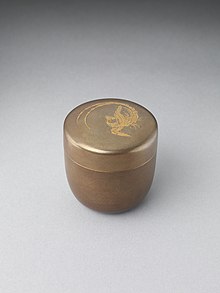Chaki
Chaki (茶器) is a Japanese term that literally means "tea implement".
The caddies generally referred to as chaki are relatively small lidded containers, and are not storage vessels.
They may also feature designs painted, applied, or carved into them, using for instance the maki-e or raden techniques.
A lacquer artist named Haneda Gorō, who lived in the era of Higashiyama culture and did lacquer work for Ashikaga Yoshimasa, is credited as the originator of this style of container for powdered tea which at first, as a rule, was black-lacquered.
[2] The basic type is the "Rikyū shape" (利休形 Rikyū-gata), which comes in three sizes: large (大棗 ō-natsume), medium (中棗 chū-natsume), and small (小棗 ko-natsume).
With the orthodox Rikyū-gata natsume, typically finished in plain black lacquer inside and out, the lid fits onto the body at about 7/10 the distance up from the base.
For example, the diameter of the flat type (平棗 hira-natsume) generally is about twice the dimension of the vessel's height.
For this was the order in which they were presented by the Shogun to one he desired to honour.The term chaire (茶入) generally refers to a relatively small ceramic jar with a lid, used to hold the tea powder for use in making thick tea (koicha).




